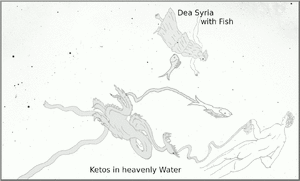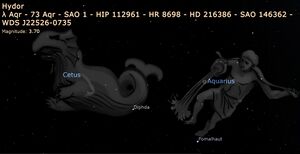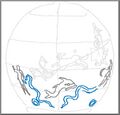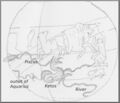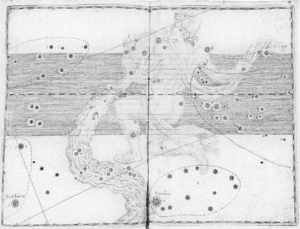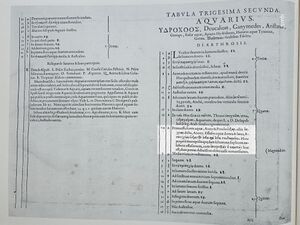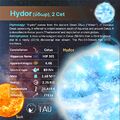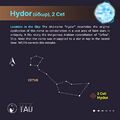Hydor (ὕδωρ)
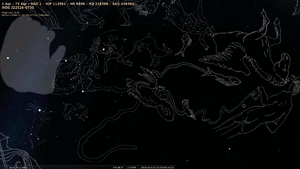
The Ancient Greek term Hydor (ὕδωρ) means "Water". It is a constellation that is only mentioned in Aratus' didactical poem "Phainomena".
Etymology and History
Ancient asterism
Aratus (4th century BCE) in his didactic poem "Phainomena" mentions an asterism "The Water" that is mentioned by no other preserved text (highlighting by us):[1][2]
Other stars lying scattered below the Water-pourer hang in the sky between the celestial Monster and the Fish, but they are faint and nameless. Close to them, like a light spray of water being sprinkled this way and that from the right hand of the illustrious Water-pourer, some pale and feeble star go round. Among them go two rather brighter stars, not so very far apart nor yet very close, onebeautiful and bright star beneath the two feet of the Water-pourer, the other below the dark Monster's tail. Men call them collectively the Water. (389-399)
These stars are in the area of the sky between the bright stars Diphda and Fomalhaut, south of the Aquarius and Cetus.
The three preserved ancient globes[3][4] depict this asterism of The Water as a vessel for the monster named "Ketos" in Greek, making it a monster living in the water (sea), a seamonster[5].
Cicero, Aratea
And nearby you will see stars, all without names, between Monster and the Fish, which we call that of the South, they are spread beneath the feet of the radiant Water Bearer. Beside this, the Water Bearer waters the dark river, which gleams through the faint shimmer of stars. Of these many, nevertheless these two lights shine far and wide: One will be recognized under the feet of the Water Bearer; what remains, having slipped down from the cold river to the springs, persists beneath the spine-bearing tail of the Monster. (414-422)
Avienus, Aratea
The other stars in the sky between the beautiful Water Bearer and the crest-bearing Sea Monster up to the shining stars of the northern Fish are all only of medium size, of powerless and weak light, for they appear scattered everywhere in the sky, nameless like the common crowd. But near the right hand of the Water Bearer, who, as they say, fills the cups for the gods at their feasts, clear water pours forth like a flowing river in two directions. Only two stars there have bright light; they are not too far apart from each other in the sky, yet their light does not merge. The flame of one shines beneath the Phrygian Youth [Aqr], while the other's radiant fireball streams its light far and wide there, where the curved tail of the Whale ends. All of these are called Water. Finally, stars also revolve near the face of the Archer, and where his hooved forefeet are to be imagined, their nebulous light dies away in dim radiance. (828-842)
Germanicus, Aratea (387-388) omits the name.
Aratus seems to have in mind the area south of Aquarius and west of Cetus (where the Arabic Ship, Safina is). However, we can also understand that from Aratus' original Greek poem and Avienus's Latin translation that the "nameless stars" between Aquarius, Cetus and Pisces seem to be called The Water. This would extend The Water further north. Note that Avienus describes the image on the Globus Farnese where Aquarius wears a Phrygian hat (he calls him "Phrygian Youth"), and all three ancient celestial globes depict The Water as surrounding Cetus.
Image Gallery
Star Name (Early Modern)
Allen (1899, page 55), under the headline "λ, 3.8, red" first presents a quotation from Bayer (1603). He states, lambda
"is the most prominent of the first stars in the Stream.
Proclus followed Aratos in calling it Ὕδωρ, [note: Hydor] the Water; and others, Ἔκχυσις, [note: "Ekkhysis"] the Outpouring; Aratos describing it,
- "Like a slight flow of water here and there,
Scattered around, bright stars revolve but small";although these titles, appropriated by Bayer for λ, originally were for the whole group set apart as the Stream."
Then, he continues with the name of a nakshatra "Catabhisaj" for λ Aqr, and only this term is highlighted in bold face (as he layouts star names) and not the name "Hydor". For "Hydor", Allen's description basically repeats Bayer (1603) Uranometria, attributing two names to Aratus and Proclus; he does not even transliterate the term (same as Bayer) and gives only the Greek letters.
| Bayer's text for λ Aqr (see image), mixed Greek and Latin | translation (English) |
|---|---|
| Prima effusionis aquae, Arato & Proclo ὕδωρ (Lat.: Hydor), aliis ἔκχας dicta, Anony. Effusio aquae dexta & laeua, Arato χύσις ὕδατ@ ἔνθα καὶ ἔνθα σκιδναμένϫ, Hinc perperá manupicta quedam schemata duplicem exhibent effusionem, cum ἐπιϛροφὰς ἢ καμπὰς hoc est, duas potius debuissent obseruasse conuersiones. | The first pouring of water, called ὕδωρ (hydōr) by Aratus and Proclus, and ἔκχας (ekchys) by others. Anonymous. The pouring of water right and left, described by Aratus as χύσις ὕδατος ἔνθα καὶ ἔνθα σκιδναμένη (chysis hydatos entha kai entha skidnamenē) [meaning 'the pouring of water scattered here and there']. Hence some hand-drawn diagrams incorrectly show a double pouring, when they should have rather observed ἐπιστροφὰς ἢ καμπὰς (epistrophas ē kampas), that is, two turns/bends. |
However, the entry in Allen (1899) seems to be one of many sloppinesses and even Bayer seems to misunderstand Aratus. In the original Aratus (4th century BCE), the term "Hydor" describes the whole huge region of faint stars:
- Aratus explicitely states "below the Water-pourer".
- The ancient globe makers depict the constellation around Cetus. It is the element that makes the monster depicted in Cetus a seamonster (because it is in Hydor!).
In both cases, the Greek Water would be south of Aquarius, but Bayer places it in the outlet of Aquarius (east of him). Thus, Bayer reinterprets the term (with the alternative reading mentioned above that The Water may even extend up to Pisces). Bayer mentions diagrams that "incorrectly show a double pouring", but this image had actually been the original Babylonian depiction of the Water-pourer (Ea/Enki), a knowledge not available at Bayer's time.
Also, Bayer's star chart has no label on λ Aqr. Note that "Fomalhaut" and "Deneb Kaitos" are labels in the map, and that Bayer actually mentions two terms "Hydor" and "Ekchys" for the area. Therefore, it is not certain that Bayer really intended to name the star λ Aqr.
Mythology
The Seamonster (Cetus) threatens Andromeda who is sacrificed to the gods and chained to a rock at the coast. She is rescued by Perseus, the Hero.
IAU Working Group Star Names

As the term Ὕδωρ originally describes an asterism and, thus, a group of many faint stars or an area in the sky, we can apply the name to any star in that area around the figure of Cetus (in Eridanus, Fornax, Cetus, Sculptor, Aquarius - although "For" doesn't make sense). The name "Hydor" (ὕδωρ) is suggested
- for 2 Cet (HIP 301, HR 9098 SIMBAD), a blue star (B9) of 4.536 mag in visible light. In modern star charts, the star is located between the tail of the Cetus-figure and the drops of the outlet of Aquarius. Alternatively, i01 Aqr (5.2 mag) or i03 Aqr (5.15 mag), for they are considered today as water drops in the outlet of Aqr. These stars are Psc-Eri-Stream with 4731 members (paper).
- or for λ Aqr as preserved in Bayer's Uranometria (1603) which is a red star (M2) of Vmag 3.79 (SIMBAD). However as a bright star in the zodiac, λ Aqr has multiple cultural aliases that may be more appropriate choices (e.g. Tibetan "Mondru" (Johnson-Groh 2013), Hindu "Śatabhiṣa (शतभिषक्)"/"Satabhisaj"/"Satabhisak" (Venketeswara & Shylaja 2016, Sarma 1997, Rudra 2006)).
The WGSN chose to adopt Hydor for the star 2 Cet, close tho the Arabian star name Safina, Ship, in the IAU-CSN.
Weblinks
- Ridpath, Ian, “Star Tales: online edition”.
Reference
- ↑ ARATUS, PHAENOMENA (online), from: Callimachus, Hymns and Epigrams. Lycophron. Aratus. Translated by Mair, A. W. & G. R. Loeb Classical Library Volume 129. London: William Heinemann, 1921. https://www.theoi.com/Text/AratusPhaenomena.html
- ↑ Arat, Phainomena, Engl. translation by Kidd, Douglas, Cambridge Univ. Press 1997
- ↑ Hipparchs Himmelsglobus – Ein Bindeglied in der babylonisch-griechischen Astrometrie?, Springer Research, Wiesbaden/ New York, 2017
- ↑ Hoffmann, Susanne M. (2024). Some Results on the three Ancient Globes, Globusfreund/ Globe Studies, ISSN
- ↑ Hoffmann, S.M., Vickers, D. and Geymeier, M. (2022). Constellation Cetus: Whale or Monster?, in: Hoffmann and Wolfschmidt (eds.). Astronomy in Culture – Cultures of Astronomy, tredition Hamburg/ OpenScienceTechnology Berlin, 287
